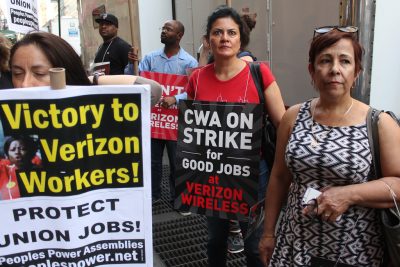On Global Capitalist Crises: The Destruction and Cooptation of the Trade Union Movement
Part IV

Read part I, II and III from the links below.
On Global Capitalist Crises: Systemic Changes and Challenges
By , June 09, 2019
On Global Capitalist Crises. Debt Defaults, Bankruptcies and Real Economy Decline
By , June 13, 2019
On Global Capitalist Crises: US Neocons and Trump’s Economic and Social Agenda
By , June 14, 2019
***
Mohsen Abdelmoumen: You have worked on trade union issues and you have been a trade unionist yourself. In the face of the fierce neoliberal offensive, do we not have a vital need for a very strong trade union movement to defend the working class?
Jack Rasmus: Absolutely. One of the great tragedies in recent decades is the destruction and co-optation of what’s left of that trade union movement. The destruction was planned in the 1970s and the implementation of a strategy of union destruction began in earnest under Reagan and has not ceased ever since. One of the greatest and most successful union strike waves in the US occurred in 1969-71 (second in scope only to 1946). Workers won wage and benefit gains of 25% in the first year of contracts at that time (1970-71). First construction trades, then teamsters, then auto and steel, then port dockworkers. Employers could not stop them. They were too well organized and remembered how still to fight from the traditions left over from the 30s and 40s. That’s when a plan was developed first to destroy the building trades. That was implemented back in the late 1970s, even before Reagan. Under Reagan the attack was directed at manufacturing and transport unions. At its core was the offshoring of their jobs and the deregulation of their industries to intensify competition to drive down wages. The beginning of the ‘contingent’ labor transformation began in the 1980s as well, then accelerated. Free trade wiped out more jobs, especially under Clinton in the 1990s. Pensions were destroyed in the private sector in the 80s and 90s. Minimum wages were allowed to lag. Healthcare costs were privatized and shifted to workers. Some workers fought back, a rear-guard action.
But the explanation for the demise of unionization in America in the private sector cannot be understood as solely the result of capitalist offensives. That was important. But so was the lack of leadership by unions at the top. They thought it would temporary, under Reagan, and they could recoup losses thereafter in membership, wages, and benefits. But it was not temporary. It continued under Democrats in the 1990s. The problem was that unions, as they weakened, turned to the Democratic Party to save them. It didn’t. As they got weaker they pleaded with Democrats even more, but the latter simply took their support for granted and did little in return. The Democrat party insisted the Unions not embarrass them by strikes, especially under Clinton. The leadership abided by the party’s request. And got weaker still, losing more members. Then came NAFTA, China, and H1-B visas giving hundreds of thousands of jobs to skilled labor coming to the US. Millions of jobs were lost after 1997 to trade. Then came tax cuts for business that subsidized the replacement of labor by capital and machinery. That devastated at least as many jobs as free trade deals. Then came the collapse of housing markets and permanent loss of millions of construction jobs. Filling the gap of jobs were more low paid service employment and more contingent part time, temp work, at lower pay and no benefits. All the while the leaders of unions pleaded with Democrats to help them. Obama promised reforms to help unions organize new members in 2008, then buried the promise once elected and having received union members’ contributions in the millions for his campaign.
The problem of declining unions is a problem of capitalist restructuring and change, of capitalist offensives to de-unionize and weaken collective bargaining. But it’s also a consequence of wrong union strategies, especially becoming more dependent on Democratic party leaders who abandoned unions once they took their campaign contributions. If unions are to resurrect themselves, and I believe they will, it will have to be an independent union movement, not depending on either wings of the corporate party of America—aka the Democrats and the Republican wings of this single, essentially capitalist party. It will probably have to assume a new kind of organizational form as well. Not organized along lines of ‘smokestacks’, for this or that industry, and not placing contracts as its key objective but forming alliances and new organizations that include allies outside of work and pursuing political-legislative objectives as equally important strategies.
Having personally lived and worked in unions when they were at their peak, and then experienced and witnessed the decline, from within and from afar, it is clear union labor will have to undergo a major organizational and strategic restructuring of its own if it is to become a force it once was. But this is not the first time historically it has undergone such a transformation and arose to resume its critical economic and political role. I’m convinced it will do it again. But only if that resurrection attempt is done independently and it breaks as an appendage of either of the wings of the corporate party of America.
*
Note to readers: please click the share buttons above or below. Forward this article to your email lists. Crosspost on your blog site, internet forums. etc.

